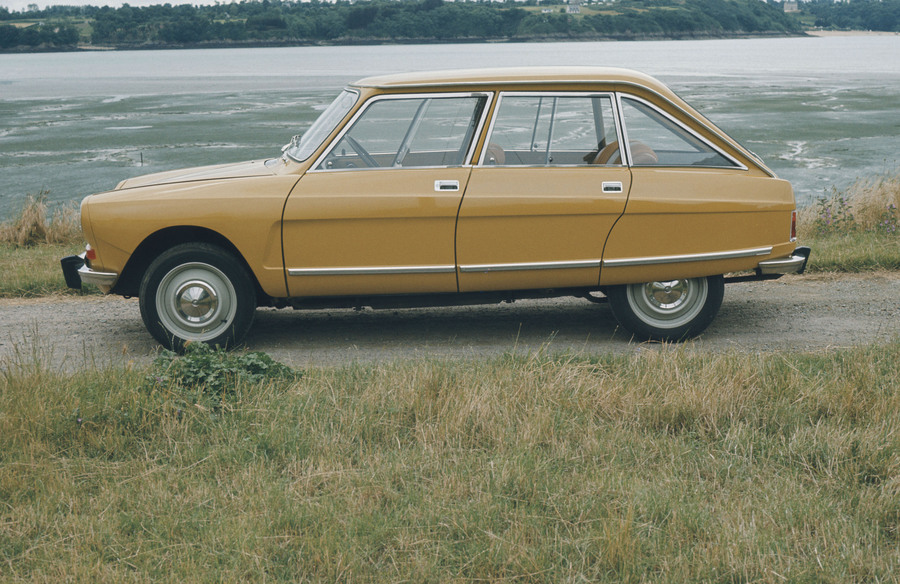A fiftieth anniversary for the Visa forerunner model. Citroën AMI8 was presented at the 1969 Geneva Motor Show. The car was an evolution of the AMI6, presented a few years earlier, in April 1961, when Citroën astonished (once again) the whole world with its interpretation of average family car, the result of the work of the Italian designer Flaminio Bertoni, already author of the Traction Avant line, of the DS19 and much of that of the 2CV.
The line of the AMI6 was a total break with the previous models: Bertoni had managed to create a comfortable four-seat and three-volume sedan, with a large 350-liter luggage compartment in less than four meters in total length, mostly using the proven 2CV mechanics and a new, more powerful 602cc displacement engine that made it possible to travel in total comfort on the hundred per hour line. He had succeeded by adopting a clever rear window with an inverted inclination, which left room for the luggage compartment at the bottom and at the top for the passengers' heads. The 'Z line' was born. The AMI6 was a real success and for two years it was the best-selling car in France. The ribs of the sheets gave it an unmistakable character, while at the same time saving weight to the advantage of consumption and performance. The arrival in 1964 of the giardinetta version, called 'Break', which added a comfortable rear hatch capable of accommodating even very bulky loads, sanctioned the success of the Citroën AMI family.
The designer who defined the lines of the AMI8 was Robert Opron, chosen as his assistant directly by Flaminio Bertoni. Opron came from Simca and would design four cars for Citroën: GS, SM, CX and VISA, of which he took care of the style of the first versions. After the sudden disappearance of Bertoni in 1965, Opron found himself in the hands of the difficult task of renewing the style of the AMI6 whose production should have continued for at least another ten years, waiting to launch a totally new model (which will then be the Visa). Thus, making use of new sheet metal forming technologies and using the new IT tools of the Citroën Style Center, Opron simplified the AMI6 line, eliminating certain refinements such as the edges of the bonnet and front fenders, changing the sedan into a 'fastback' (while maintaining the rear part of the Break unchanged) and completely redesigning the interior and the front.
Thus a substantially new car was born that maintained the general concept of the AMI6 but had a renewed mechanics, ready to face a new decade. To prepare for the arrival of the new AMI8, in February 1969 France was plastered with large 6x3 posters that contained a curious question, "what's with 8?", With amusing play on words and which remained posted until next March, when the AMI8 made its official debut at the Geneva Motor Show and the French posters were promptly replaced by others that provided the answer to the previous question: "But the AMI8", ça va sans dire ! The success of the AMI8 was immediate and lasting: the new line and the completely renewed dash pleased the general public. The bridge was partly inspired by that of the Dyane and partly anticipated that of the new GS that would be presented the following year.
Economical, safe, sturdy and easy to maintain, AMI8 guaranteed great comfort on board its occupants and was capable of speeding fast when necessary and becoming almost a van on weekends. Its independent suspension on the four wheels made even the most uneven ground soft and, with their anti-pitch system, ensured perfect stability. The new '8' brought the production of the AMI family beyond the threshold of one and a half million pieces to reach around one million eight hundred and fifty thousand at the end of production, which took place in 1978 for the sedan and the following year for the Break. The arrival of Visa, derived from a project curated by Robert Opron himself, determined the end of the production of the AMI8. Over the years the cars had come off the assembly lines of Rennes in Brittany, Vigo in Spain (where it was simply called Citroën 8) and even in Buenos Aires, where the specimens destined for Latin America were assembled.











